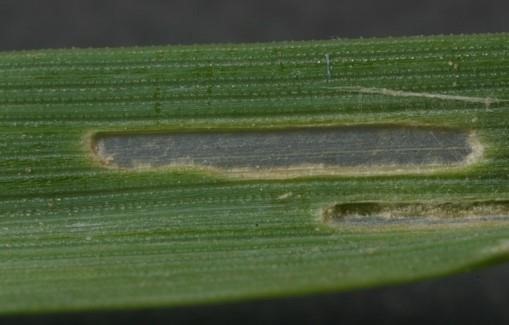In late June, large numbers of fall armyworm were being recovered from pheromone traps in the Lubbock, Texas area and the Texas panhandle. The offspring from these large flights have been emerging and are continuing to move north. Fall armyworm adults were detected in southwest Kansas pheromone traps during the first week of July and trap numbers are beginning to increase. Adult moths are most likely active throughout the southern portion of the state.
Start scouting now
At-risk crops should be scouted regularly for the remainder of the growing season. Caterpillars increase in size at an exponential rate and a majority of feeding occurs during the later stage of development. It is critical to scout thoroughly and treat, if needed, before the caterpillars are over ½ inch long. Larger caterpillars are harder to control and do the most damage. Recommended thresholds and products labeled for control of fall armyworm caterpillars (Table 1) can be found below.
Fall armyworm thresholds
Alfalfa: 1-2 caterpillars per square foot can destroy seedling alfalfa. 10-15 per square foot can destroy 12” tall plants.
Corn: damage to whorl stage in early summer; treatment may be needed if 75% of plants are damaged. Bt corn may prevent ear damage.
Sorghum: damage to whorl stage in early summer; treatment may be needed if 75% of plants are damaged. 1-2 larvae/head during flowering to soft dough reduces yield 5-10%.
Wheat: Larval “window-paning” (Figure 2) in early planted wheat can be a concern. If 25-30% of plants show damage, examine field frequently. Treat at 2-3 active larvae/ft.
Table 1. Registered products for the control of fall armyworm in Kansas crops. Always refer to the actual label on the product for more specific information relative to any insecticide.
Chemical Name | Trade Name | Mode of Action Class | Alfalfa | Corn | Sorghum | Wheat |
alpha-cypermethrin | Fastac CS | 3A | yes | yes | yes | yes |
beta-cyfluthrin | Baythroid XL | 3A | yes | yes | yes | yes |
bifenthrin | numerous products | 3A | | yes | | |
biological insecticide | Fawligen | - | | | yes | |
carbaryl | Sevin | 1A | yes | | | |
chlorantraniliprole | Vantacore | 28 | | yes | yes | yes |
cyfluthrin | Tombstone | 3A | yes | yes | | |
deltamethrin | Delta Gold | 3A | | yes | yes | |
gamma-cyhalothrin | Proaxis | 3A | yes | yes | yes | yes |
indoxacarb | Steward EC | 22A | | yes | | |
lambda-cyhalothrin+chlorantraniliprole | Besiege | 3A+28 | yes | yes | | |
lambda-cyhalothrin | numerous products | 3A | yes | yes | yes | yes |
methomyl | Lannate | 1A | yes | yes | yes | |
methoxyfenozide | Intrepid 2F | 18 | | | yes | |
permethrin | numerous products | 3A | yes | | | |
spinosad | Blackhawk | 5 | | yes | yes | yes |
zeta-cypermethrin | Mustang MAXX | 3A | yes | yes | yes | yes |
zeta-cypermethrin+bifenthrin | Hero | 3A | | yes | | |

Figure 2. Window-paning from young caterpillar feeding.
Source : ksu.edu